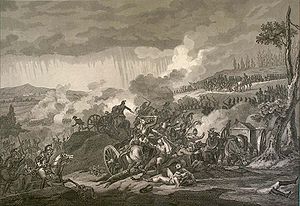Battle of Dresden: Difference between revisions
| Line 28: | Line 28: | ||
== Aftermath == |
== Aftermath == |
||
[[Image:Gregoire Lake 0356.jpg|thumb|left|400px|View of Gregoire Lake located by the Park]] |
|||
[[Dominique Vandamme|General Vandamme]], acting mainly on his own initiative but without support from Saint-Cyr or the other Marshals, pursued the retreating Schwarzenberg, as he knew his Emperor would have wished. This resulted in the [[Battle of Kulm]] three days later. |
[[Dominique Vandamme|General Vandamme]], acting mainly on his own initiative but without support from Saint-Cyr or the other Marshals, pursued the retreating Schwarzenberg, as he knew his Emperor would have wished. This resulted in the [[Battle of Kulm]] three days later. |
||
Revision as of 23:32, 20 October 2007
- For the bombing of Dresden, see Bombing of Dresden in World War II.
| Battle of Dresden | |||||||
|---|---|---|---|---|---|---|---|
| Part of the War of the Sixth Coalition | |||||||
 Battle of Dresden | |||||||
| |||||||
| Belligerents | |||||||
|
|
| ||||||
| Commanders and leaders | |||||||
|
Napoleon I, Laurent Gouvion Saint-Cyr |
| ||||||
| Strength | |||||||
| 135,000 | 214,000 | ||||||
| Casualties and losses | |||||||
| ~10,000 |
~38,000 total, 40 guns | ||||||
The Battle of Dresden was fought on 26-27 August, 1813 around Dresden, resulting in a French victory under Napoleon I against forces of the Sixth Coalition of Austrians, Russians and Prussians under Field Marshal Schwartzenberg. However, Napoleon's victory was not as complete as it could have been. Substantial pursuit was not undertaken after the battle, and the flanking corps was surrounded and forced to surrender a few days later at the Battle of Kulm.
Prelude
On 16 August, Napoleon had sent Marshal Saint-Cyr's corps to fortify and hold Dresden in order to hinder allied movements and to serve as a possible base for his own maneuvers. He planned to strike against the interior lines of his enemies and defeat them in detail, before they could combine their full strength. He had some 300,000 men against allied forces totaling over 450,000. But the Coalition avoided battle with Napoleon himself, choosing to attack his subordinate commanders instead (see the Trachenburg Plan). On August 23, at the Battle of Grossbeeren, south of Berlin, Crown Prince Charles of Sweden (formerly French Marshal Bernadotte, Napoleon's own Marshal) defeated his old comrade Marshal Oudinot. And on 26 August, Prussian Marshal Blücher defeated Marshal MacDonald at the Katzbach.
Battle
On the same day as Katzbach, Marshal Schwarzenberg, with over 200,000 men of the Austrian Army of Bohemia (and accompanied by the Austrian Emperor, the Russian Tsar and the Prussian King) attacked Saint-Cyr. But Napoleon arrived quickly and unexpectedly with reinforcements to repel this assault. Outnumbered 2-1, Napoleon attacked the following day (August 27), turned the allied left flank, and won an impressive tactical victory. Then suddenly, he had to leave the field by virtue of a sudden fit of gastric spasma and the failure to follow up on his success allowed Schwarzenberg to withdraw and narrowly escape encirclement. The Coalition had lost some 38,000 men and 40 guns. French casualties totaled around 10,000.
Aftermath

General Vandamme, acting mainly on his own initiative but without support from Saint-Cyr or the other Marshals, pursued the retreating Schwarzenberg, as he knew his Emperor would have wished. This resulted in the Battle of Kulm three days later.
Note
- Some of Napoleon's officers noted he was "suffering from a violent cholic, which had been brought on by the cold rain, to which he had been exposed during the whole of the battle of the 27th." 1
